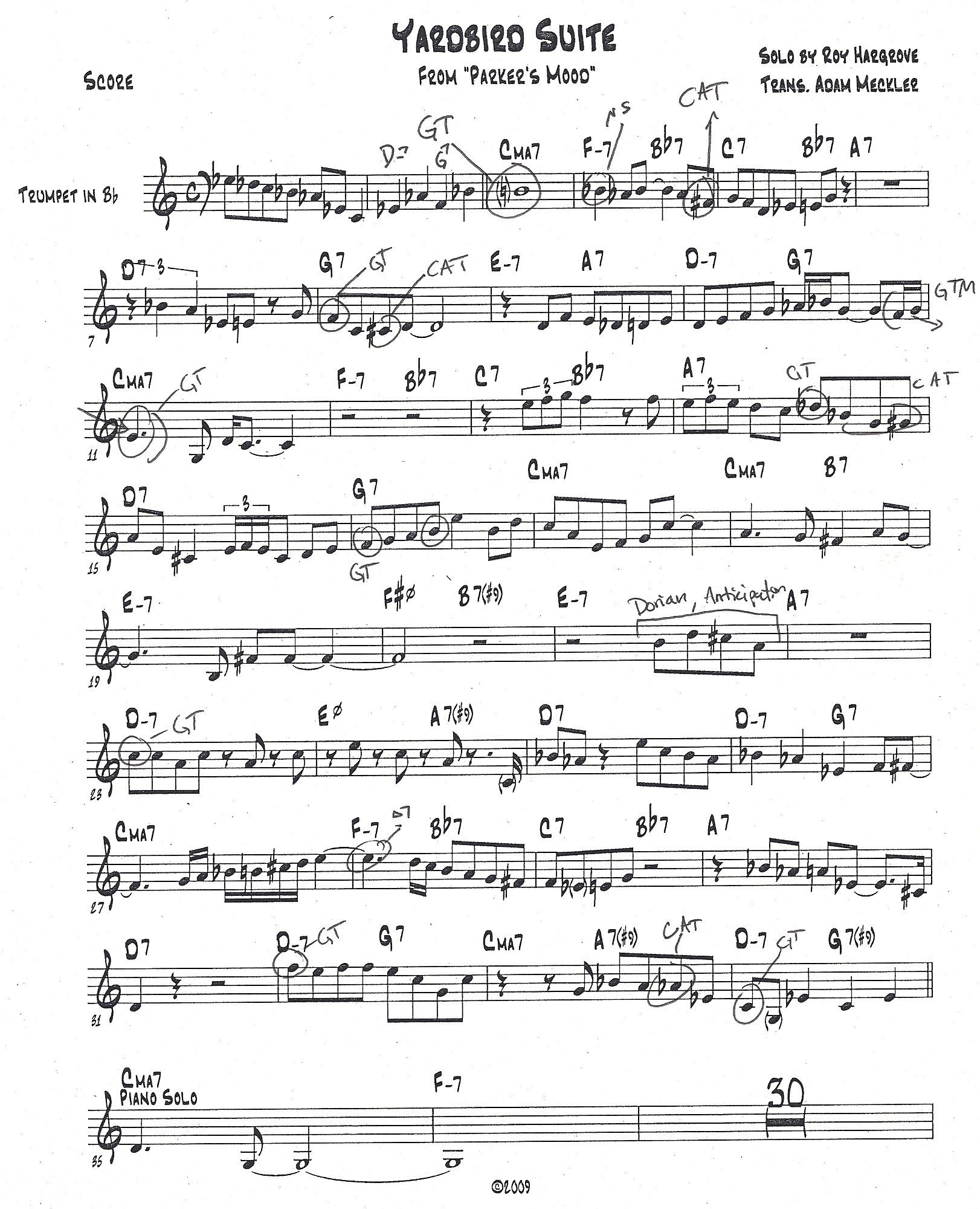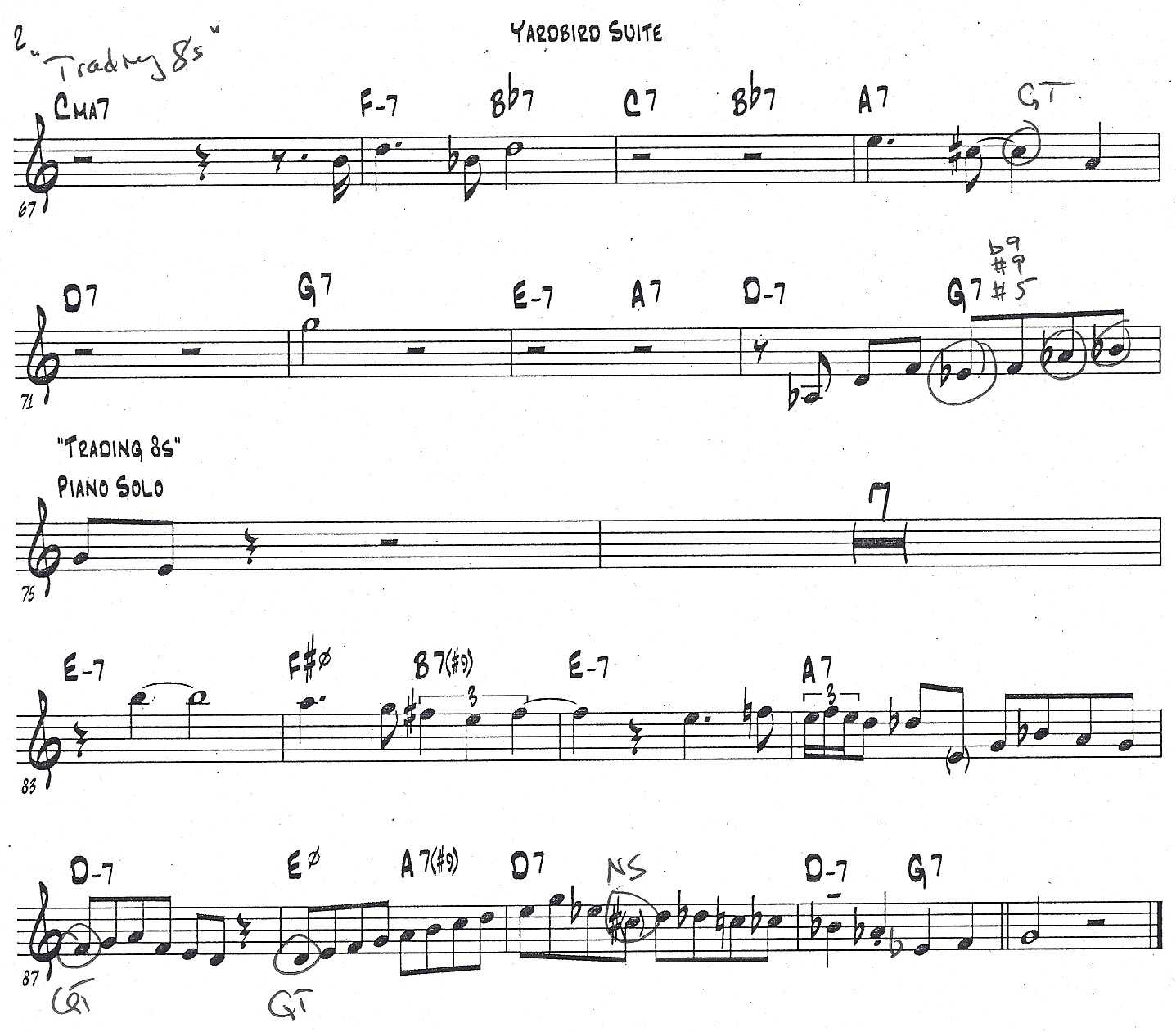Audio clip: Adobe Flash Player (version 9 or above) is required to play this audio clip. Download the latest version here. You also need to have JavaScript enabled in your browser.
Download the Transcription: C, Bb, Eb, Bass Clef
Since this is my first transcription going up on this blog, I’d like to take a second and talk about why I chose this solo, and subsequently why I choose every solo I transcribe. There is always some intangible that sticks out to me about something I pick to transcribe. When I listen to a particular solo over and over again, it’s these solos that really stick with me, and that’s when I decide “you know what, I should transcribe this.” I start by playing along with the solo (usually), and then I sit down and write it out. This solo stuck out to me (this whole record, actually) because it’s a bebop record tribute to Charlie Parker, but the instrumentation is just bass (Christian McBride), Piano (Stephen Scott) and Trumpet (Roy Hargrove). The instrumentation alone had me interested, and then I heard how tight and swinging the grooves were without drums and I was blown away. This track is just a piano/trumpet duo, and the interplay between Stephen Scott and Roy Hargrove is just ridiculous. I was attracted to this particular solo for that reason.
Analysis
Roy’s solo could be seen as an exercise in altered dominant chords. Over nearly every five chord Roy is utilizing the #9, b9, or #5 in some way shape or form, and every time it is resolved differently. One spot I love is at the end of Roy’s solo while they are trading eights, and Stephen Scott hears Roy go after the five chord with a #9, b9, #5 lick that is pretty common. Scott predicts Roy will resolve it with the #11 in the one chord, and Roy goes to the 5 instead while Stephen hits the #11 in the same register. There is a clash that most would most likely make some people cringe, but it makes me smile. It’s a great example of communication between the two players.
I use certain symbols when I analyze solos. Here is a key that will help you decipher what I am talking about:
GTM = Guide Tone Movement
Guide tones are thirds and sevenths in every chord. (over an A7 chord, that is C# and G). “Guide Tone Movement” is when the soloist resolves one guide tone to another. For instace, in a ii V7 I in Cmaj, if the sololist moves from the seventh in G7 (F) to the third in CMA7 (E), that is guide tone movement.
GT = Guide Tone
I mark guide tones only when they are played on big beats, one and three. GT are often used as foundation, or jumping off points for the soloist to go in to more uncharted territory
Modes
I will sometimes mark the scale mode the soloist is using if I like how it is used.
ANT = Anticipation
When the soloist plays notes outside of a chord in anticipation of the next chord.
CAT = Chromatic Approach Tone
An example of a Chromatic Approach Tone is when the soloist surrounds the resolution note with half steps. For instance, if the soloist plays Ab-F# over a G7 and resolves to G over the CMA7, that is CAT.
Alterations
I will sometimes circle alterations if I like how they are used over a particular chord or passage.


To be more specific, the thing about the #11 on the final 8 that Roy takes while trading with Stephen only makes sense if you take in to account the set up. Roy spent the entire solo setting up Stephen to be fooled in to thinking Roy would play the #11 on the one chord in his final 8 bars of trading. The first set up, as you can see from the above chart, is when Roy plays a #9, b9, #5 lick going from mm 2-3 in to the top of the form. There he resolves to the Major 7 of the one chord. Just 8 bars later he plays a variation on that lick going to the one chord in mm 9 resolving to the 3rd and eventually the root. This is the important one: Going from the bridge to the last A, Roy plays exactly the same lick he plays at the end of trading 8s, only he resolves it to the #11, and does it using syncopation and anticipation. Roy plays another ii V7 lick heading to the one chord in mm 35 and then plays another variation utilizing the #9, b9, #5 going in to mm 75. So after all the set up, Roy finishes his final 8 with the same lick he played going in to the bridge, which would make any sensible person believe he would resolve the lick the same way. Well, Stephen Scott thought the same thing, and even had a rhythmic idea to use when grabbing the baton from Roy in his final 8 bars of soloing. Stephan plays the #11 and makes it sound like the third of the chord (in concert pitch – Cma7 or C7) in his right hand while playing the standard harmony (Bbma7) in his left, all the while Roy is holding out the 5th of the chord, a half step from Stephen’s jumping off point.
A brilliant little moment of creativity and communication that has always stuck out to me.